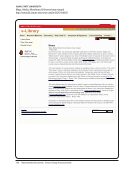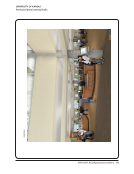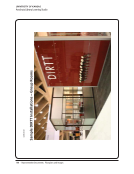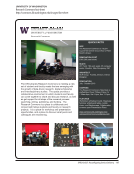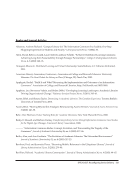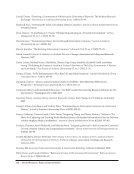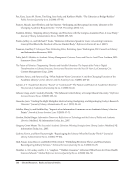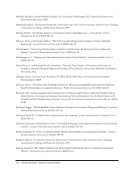SPEC Kit 327: Reconfiguring Service Delivery · 75
We are CONSIDERING closing of one or more science branch libraries (consolidating collections, etc.) and reconfiguring
space in those locations. We are considering a centralized telephone reference service, especially for weekends, for our
units in the New Brunswick/Piscataway area.
We are discussing closing several other service points in the main library: Microforms and Periodicals, and Education
Services. We are also discussing consolidating the Music and Multimedia Libraries.
We are investigating combing reference and circulation functions in the main library. We are also investigating combing
reference and circulation functions in the Science Library. With staff retirements, a small (staffed) satellite reading room
in an off-campus lab will probably be closed.
We are planning a multimedia center that will focus on multimedia production and tools, etc. Service and equipment
for microforms will move to the lower level where the circulation/reserves desk is now. Media materials and music
monuments will become self-service with some assistance given by staff from the multimedia service point. So, in a
sense, we are adding a service point and we are consolidating service for equipment and particular collections as well.
We are planning on moving our photography book collection from the Center for Creative Photography to our Science
and Engineering Library. This will make these books more available to our customers (as those collections are open
many more hours than the CCP library had been) and will also open up the space that had been used to house these
books to use as a new research center for photography scholars. The CCP’s print viewing service (where scholars could
request to view prints held in the CCP’s collection) will also be moved into this same space, consolidating all of the
CCP’s research/reference services in a single point.
We expect to add a small service desk next to the Auxiliary Storage Collection.
We have four branch libraries on campus. Zimmerman Library, the largest, is the first to undergo the Combined Service
Point transition. A comprehensive renovation of the staff space in the next 12 months will complete the transition in that
space. The circulation and reference desks in the other three branches will be following suit.
We have one remaining reading room that is staffed, in the Design College, that could conceivably close in the future.
That closing could be initiated by either the library (to save personnel costs) or the college (to recoup and repurpose the
space). It’s actually been considered (but vetoed) on two separate occasions in the past three years. Time will tell. We
also maintain a small, unstaffed reading room for our Math Department—just a few thousand volumes representing
journal backfiles (nothing currently received) in theoretical math, of very limited interest to anyone else on campus.
Again, at some point the department could ask for the space. Also, we have flirted with the idea of moving hard-copy
course reserves from our Media Center to our Circulation Desk. This would make them available for checkout all hours
the building is open, as opposed to the limited hours of the Media Center. Still under discussion.
We hope to expand our digital services efforts by creating a Center for Digital Collaboration.
We will be renovating one of our libraries which will result in changes in service points and staffing patterns.
With the opening of the new James B. Hunt Jr. Library in 2012/13 as an additional “main” library, the Textiles branch
library (5 FTE) will be closed and its services/collections will be incorporated into the Hunt Library.
With the opening of the Taylor Family Digital Library (TFDL) services will be realigned. Most importantly, Archives and
Special Collections and the Nickle Arts Museum become part of a new grouping within the TFDL called the Centre for
Arts and Culture. They will share special facilities for mediated access to primary resource collections.
We are CONSIDERING closing of one or more science branch libraries (consolidating collections, etc.) and reconfiguring
space in those locations. We are considering a centralized telephone reference service, especially for weekends, for our
units in the New Brunswick/Piscataway area.
We are discussing closing several other service points in the main library: Microforms and Periodicals, and Education
Services. We are also discussing consolidating the Music and Multimedia Libraries.
We are investigating combing reference and circulation functions in the main library. We are also investigating combing
reference and circulation functions in the Science Library. With staff retirements, a small (staffed) satellite reading room
in an off-campus lab will probably be closed.
We are planning a multimedia center that will focus on multimedia production and tools, etc. Service and equipment
for microforms will move to the lower level where the circulation/reserves desk is now. Media materials and music
monuments will become self-service with some assistance given by staff from the multimedia service point. So, in a
sense, we are adding a service point and we are consolidating service for equipment and particular collections as well.
We are planning on moving our photography book collection from the Center for Creative Photography to our Science
and Engineering Library. This will make these books more available to our customers (as those collections are open
many more hours than the CCP library had been) and will also open up the space that had been used to house these
books to use as a new research center for photography scholars. The CCP’s print viewing service (where scholars could
request to view prints held in the CCP’s collection) will also be moved into this same space, consolidating all of the
CCP’s research/reference services in a single point.
We expect to add a small service desk next to the Auxiliary Storage Collection.
We have four branch libraries on campus. Zimmerman Library, the largest, is the first to undergo the Combined Service
Point transition. A comprehensive renovation of the staff space in the next 12 months will complete the transition in that
space. The circulation and reference desks in the other three branches will be following suit.
We have one remaining reading room that is staffed, in the Design College, that could conceivably close in the future.
That closing could be initiated by either the library (to save personnel costs) or the college (to recoup and repurpose the
space). It’s actually been considered (but vetoed) on two separate occasions in the past three years. Time will tell. We
also maintain a small, unstaffed reading room for our Math Department—just a few thousand volumes representing
journal backfiles (nothing currently received) in theoretical math, of very limited interest to anyone else on campus.
Again, at some point the department could ask for the space. Also, we have flirted with the idea of moving hard-copy
course reserves from our Media Center to our Circulation Desk. This would make them available for checkout all hours
the building is open, as opposed to the limited hours of the Media Center. Still under discussion.
We hope to expand our digital services efforts by creating a Center for Digital Collaboration.
We will be renovating one of our libraries which will result in changes in service points and staffing patterns.
With the opening of the new James B. Hunt Jr. Library in 2012/13 as an additional “main” library, the Textiles branch
library (5 FTE) will be closed and its services/collections will be incorporated into the Hunt Library.
With the opening of the Taylor Family Digital Library (TFDL) services will be realigned. Most importantly, Archives and
Special Collections and the Nickle Arts Museum become part of a new grouping within the TFDL called the Centre for
Arts and Culture. They will share special facilities for mediated access to primary resource collections.




































































































































































